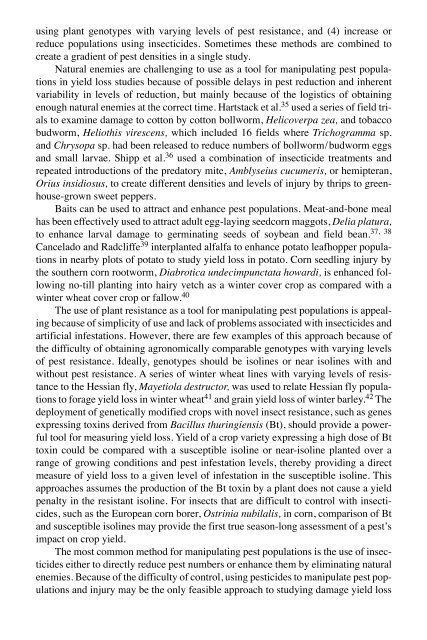Biotic Stress and Yield Loss
Biotic Stress and Yield Loss
Biotic Stress and Yield Loss
- No tags were found...
Create successful ePaper yourself
Turn your PDF publications into a flip-book with our unique Google optimized e-Paper software.
using plant genotypes with varying levels of pest resistance, <strong>and</strong> (4) increase orreduce populations using insecticides. Sometimes these methods are combined tocreate a gradient of pest densities in a single study.Natural enemies are challenging to use as a tool for manipulating pest populationsin yield loss studies because of possible delays in pest reduction <strong>and</strong> inherentvariability in levels of reduction, but mainly because of the logistics of obtainingenough natural enemies at the correct time. Hartstack et al. 35 used a series of field trialsto examine damage to cotton by cotton bollworm, Helicoverpa zea, <strong>and</strong> tobaccobudworm, Heliothis virescens, which included 16 fields where Trichogramma sp.<strong>and</strong> Chrysopa sp. had been released to reduce numbers of bollworm/budworm eggs<strong>and</strong> small larvae. Shipp et al. 36 used a combination of insecticide treatments <strong>and</strong>repeated introductions of the predatory mite, Amblyseius cucumeris, or hemipteran,Orius insidiosus, to create different densities <strong>and</strong> levels of injury by thrips to greenhouse-grownsweet peppers.Baits can be used to attract <strong>and</strong> enhance pest populations. Meat-<strong>and</strong>-bone mealhas been effectively used to attract adult egg-laying seedcorn maggots, Delia platura,to enhance larval damage to germinating seeds of soybean <strong>and</strong> field bean.37, 38Cancelado <strong>and</strong> Radcliffe 39 interplanted alfalfa to enhance potato leafhopper populationsin nearby plots of potato to study yield loss in potato. Corn seedling injury bythe southern corn rootworm, Diabrotica undecimpunctata howardi, is enhanced followingno-till planting into hairy vetch as a winter cover crop as compared with awinter wheat cover crop or fallow. 40The use of plant resistance as a tool for manipulating pest populations is appealingbecause of simplicity of use <strong>and</strong> lack of problems associated with insecticides <strong>and</strong>artificial infestations. However, there are few examples of this approach because ofthe difficulty of obtaining agronomically comparable genotypes with varying levelsof pest resistance. Ideally, genotypes should be isolines or near isolines with <strong>and</strong>without pest resistance. A series of winter wheat lines with varying levels of resistanceto the Hessian fly, Mayetiola destructor, was used to relate Hessian fly populationsto forage yield loss in winter wheat 41 <strong>and</strong> grain yield loss of winter barley. 42 Thedeployment of genetically modified crops with novel insect resistance, such as genesexpressing toxins derived from Bacillus thuringiensis (Bt), should provide a powerfultool for measuring yield loss. <strong>Yield</strong> of a crop variety expressing a high dose of Bttoxin could be compared with a susceptible isoline or near-isoline planted over arange of growing conditions <strong>and</strong> pest infestation levels, thereby providing a directmeasure of yield loss to a given level of infestation in the susceptible isoline. Thisapproaches assumes the production of the Bt toxin by a plant does not cause a yieldpenalty in the resistant isoline. For insects that are difficult to control with insecticides,such as the European corn borer, Ostrinia nubilalis, in corn, comparison of Bt<strong>and</strong> susceptible isolines may provide the first true season-long assessment of a pest’simpact on crop yield.The most common method for manipulating pest populations is the use of insecticideseither to directly reduce pest numbers or enhance them by eliminating naturalenemies. Because of the difficulty of control, using pesticides to manipulate pest populations<strong>and</strong> injury may be the only feasible approach to studying damage yield loss

















